Cultural heritage sites play a crucial role in shaping urban identity and preserving community history. This article explores effective urban photography techniques, challenges faced by photographers, and the impact of visual storytelling on community engagement. It also highlights popular cultural landmarks and emerging trends in photography that enhance appreciation and preservation efforts.

What role do cultural heritage sites play in urban identity?
Cultural heritage sites significantly shape urban identity by preserving history and fostering community pride. They serve as tangible links to the past, allowing residents and visitors to connect with local narratives. These sites also enhance the aesthetic appeal of urban areas, contributing to tourism and economic development. Additionally, they promote cultural diversity by showcasing various historical influences, enriching the urban landscape. Through urban photography, these sites can be documented, highlighting their importance in defining the character and identity of cities.
How do urban photography practices capture the essence of these sites?
Urban photography practices effectively capture the essence of cultural heritage sites by highlighting their historical significance and unique identities. These practices utilize composition, light, and perspective to evoke emotions and tell stories. Photographers often focus on architectural details, local interactions, and the surrounding environment, creating a visual narrative that showcases the site’s cultural value. By documenting these elements, urban photography contributes to the preservation of history and fosters a deeper appreciation for cultural heritage among viewers.
Why is documentation important for preserving cultural heritage?
Documentation is crucial for preserving cultural heritage as it ensures accurate representation and understanding of historical sites. It captures details about their significance, architecture, and cultural narratives. This process aids in safeguarding identity, educating future generations, and promoting awareness. Urban photography plays a vital role in this documentation by visually chronicling these sites, highlighting their unique attributes. As a result, it fosters appreciation and encourages conservation efforts within communities.
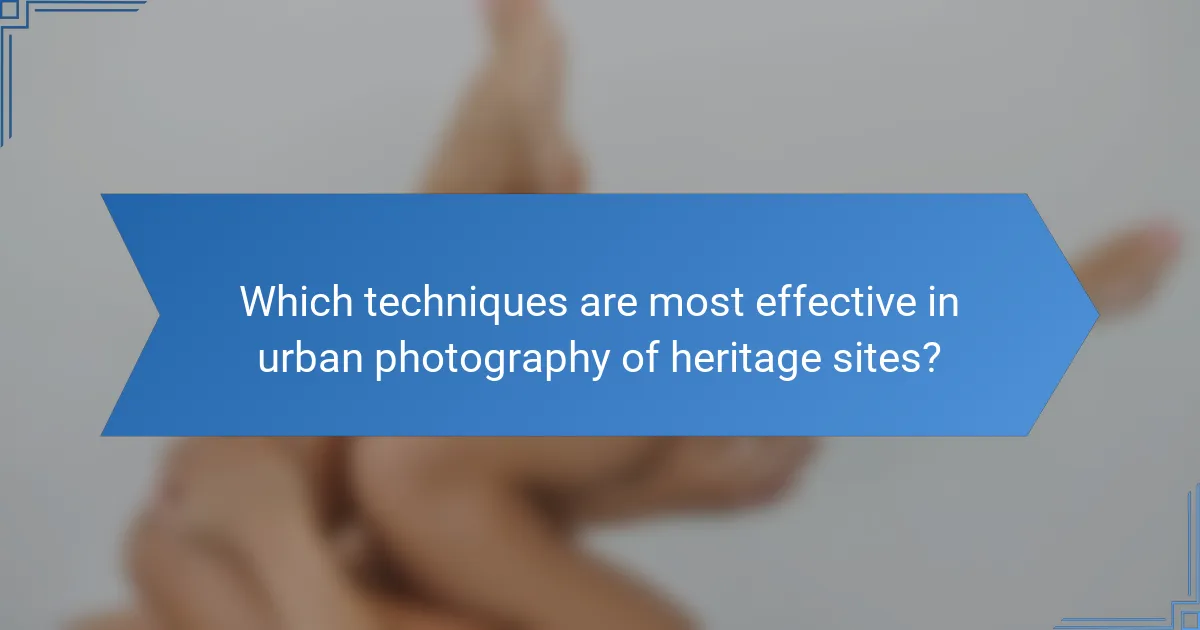
Which techniques are most effective in urban photography of heritage sites?
Effective techniques in urban photography of heritage sites include using natural light, capturing details, and incorporating context. These methods enhance the storytelling aspect of cultural heritage, showcasing both architectural features and the surrounding environment. Utilizing angles and perspectives can also create unique compositions that emphasize the site’s significance. Experimenting with different times of day can yield varied results, highlighting textures and colors that reflect the site’s history.
What are the best practices for photographing architectural details?
To effectively photograph architectural details, focus on lighting, composition, and context. Use natural light to highlight textures and shadows, and choose angles that emphasize the structure’s unique attributes.
Experiment with various focal lengths to capture both wide shots and intricate details. Incorporate elements of the surrounding environment to provide context and enhance the narrative.
Lastly, consider the time of day; golden hour can create stunning effects on building facades. Understanding these practices will enrich your documentation of cultural heritage sites.
How can lighting and time of day enhance the portrayal of heritage sites?
Lighting and time of day significantly enhance the portrayal of cultural heritage sites by creating dynamic visual narratives. The golden hour, shortly after sunrise or before sunset, casts warm light that accentuates textures and colors, revealing intricate architectural details. Shadows play a crucial role, adding depth and dimension, which can evoke emotions tied to history and identity.
Different lighting conditions can transform the mood of a site; for example, overcast skies provide a soft, diffused light that can highlight the solemnity of historical landmarks. Photographers often leverage these variations to capture unique perspectives, showcasing the essence of heritage sites.
In urban photography, understanding how natural light interacts with structures helps convey stories, allowing viewers to connect with the past. This approach not only documents history but also fosters appreciation for cultural identity, making the experience more meaningful.
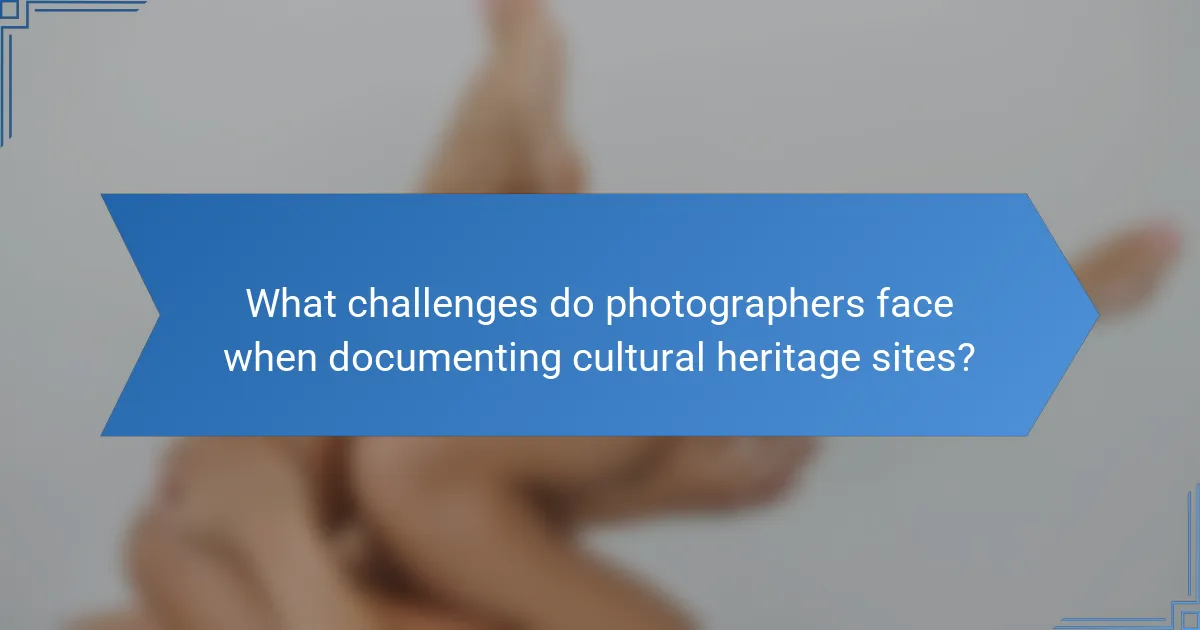
What challenges do photographers face when documenting cultural heritage sites?
Photographers face several challenges when documenting cultural heritage sites. Limited access to certain areas often restricts capturing full perspectives. Environmental factors like weather can affect visibility and lighting. Additionally, balancing authenticity with modern influences complicates representation. Preservation concerns may limit the use of equipment or techniques. Lastly, cultural sensitivity requires understanding local customs and narratives.
How do urban environments impact the preservation of these sites?
Urban environments can both enhance and hinder the preservation of cultural heritage sites. Rapid urbanization often leads to increased infrastructure development, which can threaten historical locations. However, urban photography can document these sites, capturing their essence and raising awareness. Preservation efforts can benefit from community engagement, promoting the value of heritage in urban settings. Urban environments can serve as a backdrop that highlights the contrast between modernity and historical significance, enriching the narrative of cultural identity.
What ethical considerations should photographers keep in mind?
Photographers should prioritize respect for cultural significance, obtain necessary permissions, and be sensitive to local customs. Understanding the historical context enhances the authenticity of urban photography. Ethical considerations also include representing communities accurately and avoiding exploitation. Engaging with local voices fosters trust and enriches the narrative while preserving the integrity of cultural heritage sites.
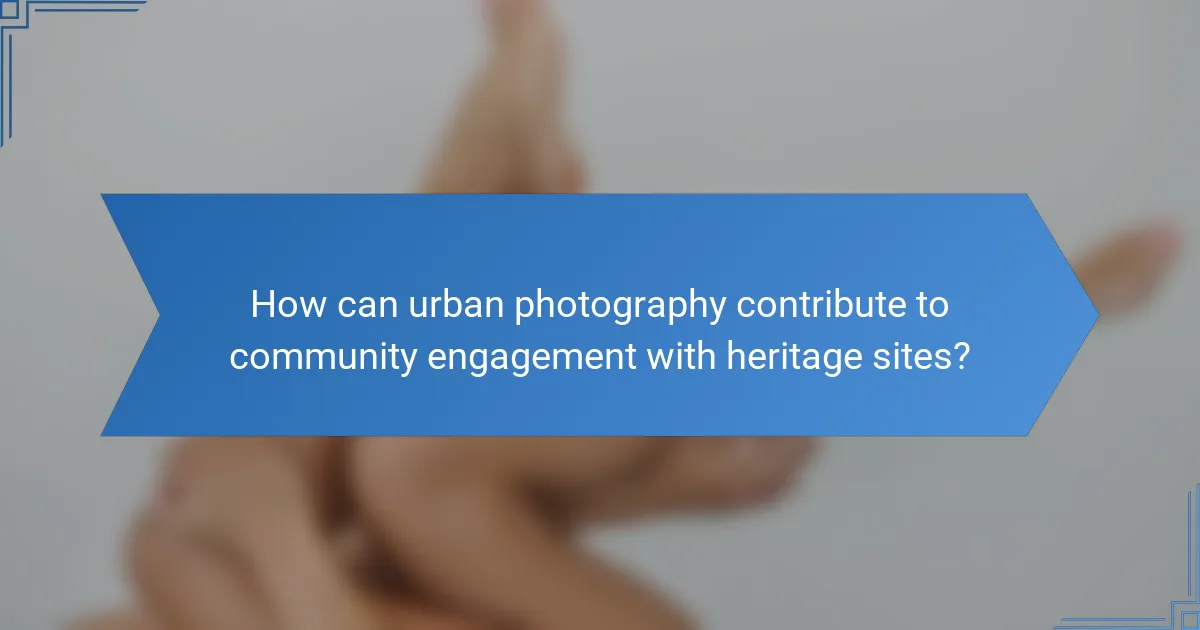
How can urban photography contribute to community engagement with heritage sites?
Urban photography enhances community engagement with heritage sites by visually narrating their historical and cultural significance. This art form fosters a sense of identity and belonging among residents. Through shared images, communities can connect with their past and promote preservation efforts. Engaging local photographers can provide unique perspectives, showcasing rare attributes of these sites. As a result, urban photography serves as a catalyst for dialogue and collaboration within the community, enriching the appreciation of cultural heritage.
What role do social media platforms play in sharing urban photography?
Social media platforms play a crucial role in sharing urban photography by providing a global audience for cultural heritage sites. They enable photographers to showcase their work, connect with like-minded individuals, and raise awareness about historical landmarks. Platforms like Instagram and Facebook allow users to tag locations, enhancing visibility and encouraging exploration. The unique attribute of social media is its instant feedback mechanism, which fosters community engagement and dialogue around urban photography. This interaction helps preserve and promote cultural identity through visual storytelling.
How can local communities participate in the documentation process?
Local communities can actively engage in documenting cultural heritage sites through urban photography by participating in workshops, collaborating with local historians, and sharing their own images and stories. This involvement fosters a deeper connection to their history and identity. Community-led initiatives can include organizing photo walks, creating local exhibitions, and utilizing social media to highlight unique aspects of their heritage. Such efforts not only preserve history but also promote cultural appreciation and awareness among residents and visitors alike.
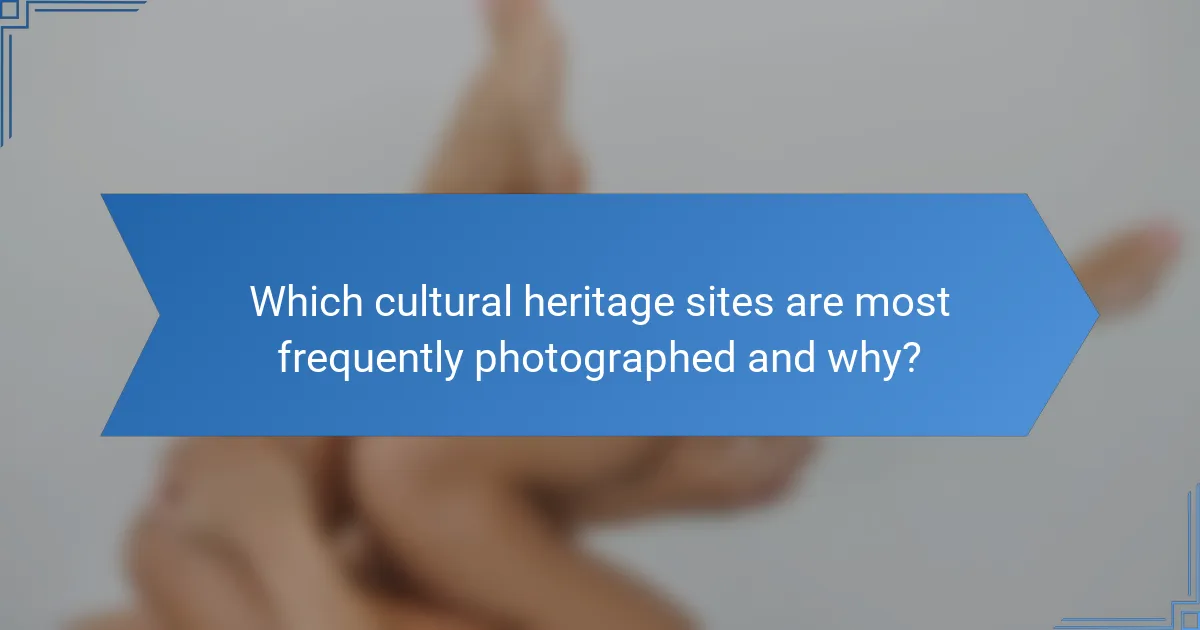
Which cultural heritage sites are most frequently photographed and why?
Cultural heritage sites most frequently photographed include the Eiffel Tower, the Colosseum, and Machu Picchu due to their iconic status and historical significance. These sites attract millions of visitors annually, serving as symbols of cultural identity. The visual appeal of their architecture and landscapes enhances their popularity among photographers. Additionally, social media trends amplify interest, encouraging more people to capture and share images of these landmarks.
What unique attributes distinguish lesser-known heritage sites in urban photography?
Unique attributes that distinguish lesser-known heritage sites in urban photography include their authentic cultural narratives, architectural diversity, and community significance. These sites often showcase unique local craftsmanship and traditions, reflecting the identity of the area. Their hidden locations provide opportunities for discovering untold stories, enhancing the richness of urban photography. Additionally, lesser-known sites frequently feature rare historical artifacts and lesser-explored architectural styles, contributing to a more nuanced representation of urban heritage.
How do different regions prioritize their cultural heritage in photography?
Different regions prioritize their cultural heritage in photography based on local values and historical significance. Urban photography often reflects unique architectural styles, traditions, and social narratives. For instance, European cities may emphasize historical landmarks, while Asian regions might focus on vibrant street life and festivals. This diversity showcases how cultural identity is visually documented across various contexts. Regional priorities are influenced by community engagement, tourism, and preservation efforts, highlighting the importance of cultural heritage in shaping urban landscapes.
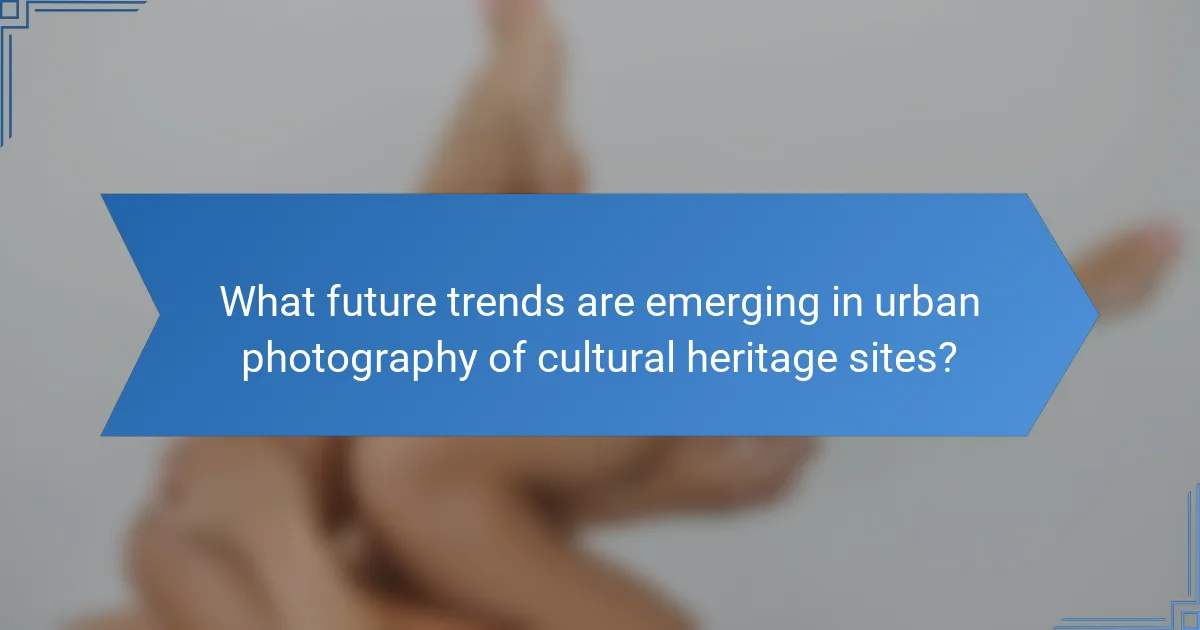
What future trends are emerging in urban photography of cultural heritage sites?
Emerging trends in urban photography of cultural heritage sites focus on sustainability, technology integration, and community engagement. Photographers increasingly use drones for aerial perspectives, capturing the scale and context of heritage sites. Additionally, augmented reality enhances viewer interaction, allowing immersive experiences that educate about history. Social media platforms serve as vital tools for sharing these images, fostering global awareness and appreciation. As a result, urban photography is evolving into a collaborative medium that highlights cultural significance while promoting preservation efforts.
How do technological advancements influence documentation methods?
Technological advancements significantly enhance documentation methods for cultural heritage sites. Digital photography, drones, and 3D scanning provide detailed visual records, preserving history and identity. These tools improve accessibility and engagement, allowing wider audiences to experience urban photography. As a result, documentation evolves to include interactive and immersive elements, enriching cultural narratives.
What are the implications of virtual reality and augmented reality in heritage photography?
Virtual reality and augmented reality enhance heritage photography by providing immersive experiences that engage viewers. These technologies allow for interactive exploration of cultural heritage sites, enabling users to visualize historical contexts and architectural details.
For instance, augmented reality can overlay historical images or information onto current photographs, enriching narratives and fostering a deeper connection to heritage. Virtual reality can simulate visits to remote or endangered sites, preserving their essence for future generations.
The unique attribute of these technologies lies in their ability to create a multisensory experience, transforming static images into dynamic stories. This innovation not only documents history but also reinforces community identity and cultural significance.
What practical tips can photographers follow to enhance their work with cultural heritage sites?
Photographers can enhance their work with cultural heritage sites by focusing on composition, lighting, and storytelling. Utilize natural light during golden hours for striking images. Incorporate leading lines and symmetry to create engaging compositions. Research the site’s history to capture its essence and convey a narrative through your photographs. Engage with local communities to gain insights and perspectives that enrich your work. Experiment with different angles and perspectives to highlight unique attributes of the site.